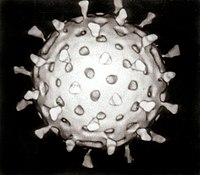
Photo from wikipedia
This cross-sectional descriptive study aimed to investigate the incidence of rotavirus and enteric bacterial infections among children up to 5 years old with diarrhea living in suburban and rural areas… Click to show full abstract
This cross-sectional descriptive study aimed to investigate the incidence of rotavirus and enteric bacterial infections among children up to 5 years old with diarrhea living in suburban and rural areas of Kenya. Between August 2011 and December 2013, a total of 1,060 diarrheal fecal specimens were obtained from 722 children at Kiambu County Hospital (KCH), located in a suburban area, and from 338 children from Mbita District Hospital (MDH), located in a rural part of western Kenya. Of the 1,060 isolates, group A rotavirus was detected in 29.6% (214/722) and 11.2% (38/338) fecal specimens from KCH and MDH, respectively. Diarrheagenic Escherichia coli (DEC) was found to be the most frequently isolated bacterial pathogens in both study areas (32.8% at KCH and 44.1% at MDH). Two different mixed infection patterns (virus/bacteria and bacteria/bacteria) were observed among patients. A significantly higher infection rate of rotavirus (17.6%, p = 0.001) and DEC (10.5%, p = 0.007) were observed during the dry season. Our study found that in both suburban and rural settings in Kenya, rotavirus and DEC are the principal cause of pediatric diarrhea and exhibit higher incidence during the dry season.
Journal Title: Japanese journal of infectious diseases
Year Published: 2017
Link to full text (if available)
Share on Social Media: Sign Up to like & get
recommendations!